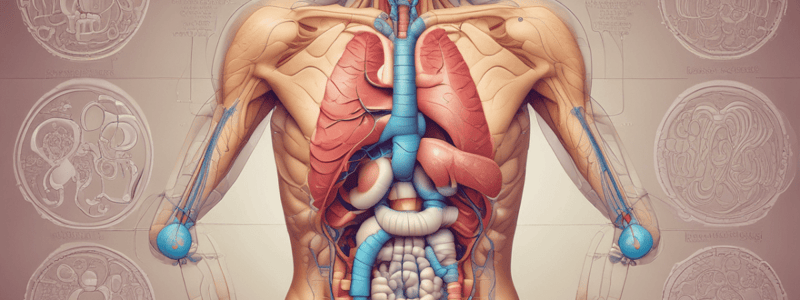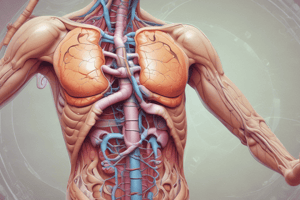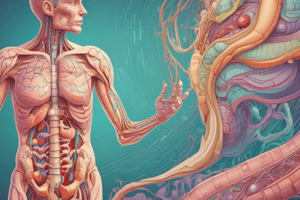Podcast
Questions and Answers
What is the role of phospholipids in the solubility of cholesterol in bile?
What is the role of phospholipids in the solubility of cholesterol in bile?
- They form vesicles with cholesterol making it soluble. (correct)
- They act as stimulants for bile production.
- They prevent cholesterol from crystallizing in the gallbladder.
- They are the primary source of bile acids.
Which physiological function is most closely associated with bile acids in the intestine?
Which physiological function is most closely associated with bile acids in the intestine?
- Direct digestion of carbohydrates.
- Activation of pancreatic enzymes.
- Facilitation of nutrient absorption. (correct)
- Production of hormones.
Which relationship is significant in understanding bile flow from the liver?
Which relationship is significant in understanding bile flow from the liver?
- Bile flow is independent of blood pressure.
- Bile flow increases with decreased oxygen delivery.
- Bile flow is inversely proportional to liver blood flow.
- Bile flow is directly related to liver blood flow and oxygen delivery. (correct)
What is a potential clinical consequence of bile acid deficiency?
What is a potential clinical consequence of bile acid deficiency?
What is the primary mechanism through which biliary disease may develop?
What is the primary mechanism through which biliary disease may develop?
How do bile acids help ensure cholesterol remains soluble?
How do bile acids help ensure cholesterol remains soluble?
What is the main role of bilirubin transport in the liver?
What is the main role of bilirubin transport in the liver?
What can affect the concentration of bile acids in the gallbladder?
What can affect the concentration of bile acids in the gallbladder?
Flashcards are hidden until you start studying
Study Notes
Overview of the Digestive System
- The digestive system includes organs responsible for the breakdown and absorption of nutrients.
- Key organs involved are the mouth, esophagus, stomach, intestines, liver, pancreas, and gallbladder.
Digestion and Absorption of Nutrients
- Nutrient absorption occurs primarily in the small intestine.
- The process involves enzymatic breakdown of macromolecules into absorbable units like amino acids, fatty acids, and monosaccharides.
Salivary, Gastric, and Pancreatic Secretions
- Salivary glands produce saliva, initiating carbohydrate digestion.
- Gastric secretions contain hydrochloric acid and pepsin to digest proteins.
- The pancreas secretes digestive enzymes (lipases, amylases, proteases) and bicarbonate to neutralize stomach acid.
Bile and Biliary System
- Bile, produced by the liver, emulsifies fats and facilitates their absorption.
- Bile salts are derived from cholesterol and play critical roles in the digestion of lipids.
- Biliary system regulates bile storage and secretion into the intestine.
Functions of Bile Acids
- Bile acids enhance fat digestion and absorption by forming micelles.
- They facilitate the solubility of cholesterol in bile, preventing gallstone formation.
Clinical Consequences of Bile Acid Deficiency
- Deficiency can lead to malabsorption of fats, resulting in nutritional deficiencies.
- Conditions may include fat malabsorption syndromes, which require clinical management.
Transport of Bilirubin
- Bilirubin, a breakdown product of hemoglobin, is transported in plasma bound to albumin.
- The liver processes bilirubin into a water-soluble form for excretion in bile.
Relationship Between Bile Flow and Liver Blood Flow
- Bile flow is influenced by liver blood flow and oxygen delivery to hepatocytes.
- Increased blood flow enhances bile production and secretion from liver cells.
Biliary Pressure and Blood Pressure Relationship
- Biliary pressure is crucial for bile transport; it is balanced with systemic blood pressure to maintain liver function.
Pathophysiology of Biliary Disease
- Biliary diseases can arise from abnormalities in bile composition, anatomy, or function.
- Cholesterol must be emulsified in bile via phospholipids to maintain solubility and prevent precipitation in the gallbladder.
Studying That Suits You
Use AI to generate personalized quizzes and flashcards to suit your learning preferences.




